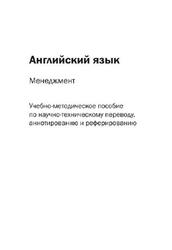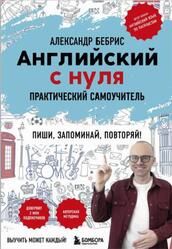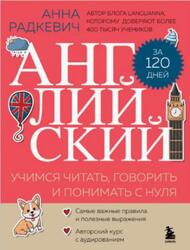Опыт обобщения практики двустороннего перевода, Английский и русский языки, Томина Ж.Д., Галкина И.Ю., Рогатин В.А., 2021.
Практикум состоит из трех разделов. В первом разделе рассматриваются вопросы общей и частной теории перевода. Второй раздел содержит упражнения по специальной теории перевода. В третьем разделе анализируются особенности устного перевода.
Практикум предназначен для студентов старших курсов бакалавриата, обучающихся по направлению подготовки 45.03.02 «Лингвистика» (направленность/профиль «Перевод и переводоведение»). Учебный материал может быть также использован в магистерских программах по филологии и методике обучения переводу.
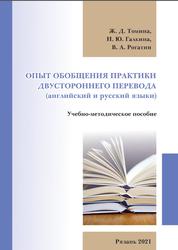
The notion of equivalence.
Guess the term by its description. To find the required information, use the reference sources (Leonardi; Комиссаров, Коралова).
• Taber and Nida maintain that this type of equivalence focuses attention on the message itself, in both form and content. It consists in finding a TL item which is identical to a SL word or phrase. There are very few equivalents of this type between language pairs. Usually such equivalents can be found among terms (Potassium), proper names (Genghis Khan). Sometimes (though very rarely) this type of equivalence can be found at the level of a sentence (She lives in New York). But the translator should remember that even when an equivalent of this kind may be found, its usage in translation can distort the grammatical, stylistic, semantic or pragmatic patterns of the target language, and hence distort the message, making its meaning vague for the target audience (He decided to stretch his legs).
• Taber and Nida state that this type of equivalence is based upon the principle of equivalent effect. It can be treated as a translation principle according to which a translator seeks to render the meaning of the original in such a way that the TL wording will trigger the same impact on the target text audience as the original wording did upon the source text audience. The formal component of the original text is changed, but the message is preserved and the translation is faithful and produces an adequate effect on the target readers.
ОГЛАВЛЕНИЕ.
Foreword.
Part 1. Lexical and Grammatical Challenges of Translation.
Workshop 1. Translation as a Multifaceted Phenomenon.
1.1. Translation as an object of scholarly research.
1.2. Translation as a process and communication.
1.3. Analysis of the communicative situation from the translator’s perspective.
1.4. Translation Models.
Workshop 2. Equivalence in Translation.
2.1. Theory of untranslatability.
2.2. The unit of translation.
2.3. The notion of equivalence.
Workshop 3. Translating Context-free and Context-bound Words.
3.1. The notion of context.
3.2. Context-free words and the challenges they present.
3.3. Context-bound words and the challenges they present.
3.4. Internationalisms and pseudo-international words and the challenges they present.
Workshop 4. Non-equivalent Words and the Challenges they Present.
4.1. Culture-bound words and the challenges they present.
4.2. Translation challenges presented by neologisms and archaisms.
Workshop 5. Translating Collocations and Phrases.
5.1. Translating attributive clusters.
5.2. Translating phraseological units.
Workshop 6. Lexical Translation Techniques.
Workshop 7. Coherence and Cohesion in Translation.
7.1. Theme and rheme as a translation challenge.
7.2. Translating monorhemes and diarhemes.
Workshop 8. Translating Passive Voice.
Workshop 9. Translating Verbals.
9.1. Translating participles.
9.2. Translating gerunds and infinitives.
Workshop 10. Grammatical Translation Techniques.
Part 2. Functional Styles and Translation.
Workshop 1. Text as a Unit of Translation and an Object of Translatological Research.
1.1. Types, Kinds, and Individuality of Texts as Viewed from the Translator’s Perspective.
1.2.Types of Translation.
Workshop 2. Translating Scientific and Technical Style.
Workshop 3. Translating Bureaucratic Style.
Workshop 4. Translating Journalistic (Publicistic) Style.
Part 3. Oral Interpretation.
Workshop 1. Oral Interpretation and its types.
Workshop 2. Consecutive Interpretation.
Workshop 3. Sight Interpretation.
Workshop 4. Simultaneous Interpretation.
Список использованных источников.
Бесплатно скачать электронную книгу в удобном формате, смотреть и читать:
Скачать книгу Опыт обобщения практики двустороннего перевода, Английский и русский языки, Томина Ж.Д., Галкина И.Ю., Рогатин В.А., 2021 - fileskachat.com, быстрое и бесплатное скачивание.
Скачать pdf
Ниже можно купить эту книгу, если она есть в продаже, и похожие книги по лучшей цене со скидкой с доставкой по всей России.Купить книги
Скачать - pdf - Яндекс.Диск.
Дата публикации:
Теги: учебник по английскому языку :: английский язык :: Томина :: Галкина :: Рогатин
Смотрите также учебники, книги и учебные материалы:
Следующие учебники и книги:
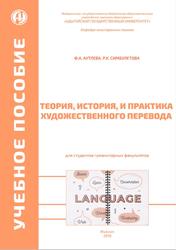 Теория, история и практика художественного перевода, учебное пособие для студентов гуманитарных факультетов, Аутлева Ф.А., Симбулетова Р.К., 2019 — Теория, история и практика художественного перевода. Учебное пособие для студентов гуманитарных факультетов, Аутлева Ф.А., Симбулетова Р.К., 2019. В данном учебном … Книги по английскому языку
Теория, история и практика художественного перевода, учебное пособие для студентов гуманитарных факультетов, Аутлева Ф.А., Симбулетова Р.К., 2019 — Теория, история и практика художественного перевода. Учебное пособие для студентов гуманитарных факультетов, Аутлева Ф.А., Симбулетова Р.К., 2019. В данном учебном … Книги по английскому языку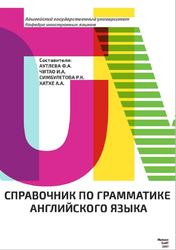 Справочник по грамматике английского языка, учебное пособие, Аутлева Ф.А., Читао И.А., Симбулетова Р.К., Хатхе А.А., 2017 — Настоящий справочник по грамматике английского языка является приложением к фонетическому пособию по английскому языку. Необходимость его создания вызвана отсутствием подобной … Книги по английскому языку
Справочник по грамматике английского языка, учебное пособие, Аутлева Ф.А., Читао И.А., Симбулетова Р.К., Хатхе А.А., 2017 — Настоящий справочник по грамматике английского языка является приложением к фонетическому пособию по английскому языку. Необходимость его создания вызвана отсутствием подобной … Книги по английскому языку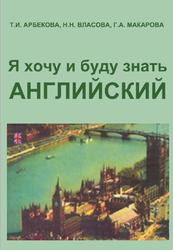 Я хочу и буду знать английский, учебник, Арбекова Т.И., Власова Н.Н., Макарова Г.А., 2002 — Учебник предназначен для лиц, овладевших основами английского языка и продолжающих его изучение, под контролем преподавателя или самостоятельно в режиме консультаций. … Книги по английскому языку
Я хочу и буду знать английский, учебник, Арбекова Т.И., Власова Н.Н., Макарова Г.А., 2002 — Учебник предназначен для лиц, овладевших основами английского языка и продолжающих его изучение, под контролем преподавателя или самостоятельно в режиме консультаций. … Книги по английскому языку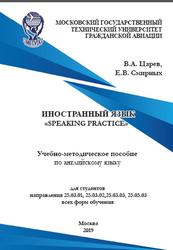 Иностранный язык, Speaking practice, учебно-методическое пособие по английскому языку, Царев В.А., Смирных Е.В., 2019 — Данное учебно-методическое пособие издается в соответствии с рабочей программой учебной дисциплины Иностранный язык по учебному плану для студентов направления 25.03.01, … Книги по английскому языку
Иностранный язык, Speaking practice, учебно-методическое пособие по английскому языку, Царев В.А., Смирных Е.В., 2019 — Данное учебно-методическое пособие издается в соответствии с рабочей программой учебной дисциплины Иностранный язык по учебному плану для студентов направления 25.03.01, … Книги по английскому языку
Предыдущие статьи:
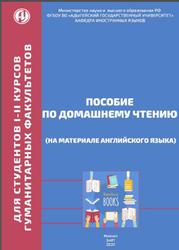 Пособие по домашнему чтению для студентов 1-2 курсов гуманитарных факультетов, На материале английского языка, Тешева М.М., Читао И.А., Хатхе А.А., 2020 — Пособие по домашнему чтению включает тексты, которые направлены на расширение и закрепление лексики, развитие навыков чтения и перевода аутентичных текстов, … Книги по английскому языку
Пособие по домашнему чтению для студентов 1-2 курсов гуманитарных факультетов, На материале английского языка, Тешева М.М., Читао И.А., Хатхе А.А., 2020 — Пособие по домашнему чтению включает тексты, которые направлены на расширение и закрепление лексики, развитие навыков чтения и перевода аутентичных текстов, … Книги по английскому языку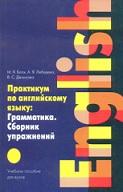 Практикум по английскому языку, грамматика, Блох М.Я., Лебедева А.Я., Денисова B.C., 2005 — Данное пособие представляет собой систематизированный сборник упражнений по грамматике английского языка. Пособие состоит из двух основных частей: морфологии и синтаксиса. … Книги по английскому языку
Практикум по английскому языку, грамматика, Блох М.Я., Лебедева А.Я., Денисова B.C., 2005 — Данное пособие представляет собой систематизированный сборник упражнений по грамматике английского языка. Пособие состоит из двух основных частей: морфологии и синтаксиса. … Книги по английскому языку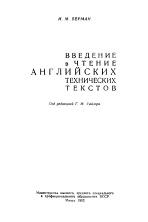 Введение в чтение английских технических текстов, Берман И.М., Уайзер Г.М., 1963 — ПРЕДИСЛОВИЕ. Настоящее Введение в чтение английских технических текстов представляет собой учебное пособие, которое должно помочь студентам втузов и читателю английской … Книги по английскому языку
Введение в чтение английских технических текстов, Берман И.М., Уайзер Г.М., 1963 — ПРЕДИСЛОВИЕ. Настоящее Введение в чтение английских технических текстов представляет собой учебное пособие, которое должно помочь студентам втузов и читателю английской … Книги по английскому языку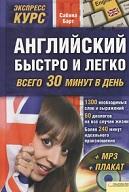 Английский быстро и легко, всего 30 минут день, Барт С., 2012 — Предисловие. Английский быстро easy это современный подробный курс для студентов начального и продвинутого уровня. С этим курсом вы шаг за … Книги по английскому языку
Английский быстро и легко, всего 30 минут день, Барт С., 2012 — Предисловие. Английский быстро easy это современный подробный курс для студентов начального и продвинутого уровня. С этим курсом вы шаг за … Книги по английскому языку

